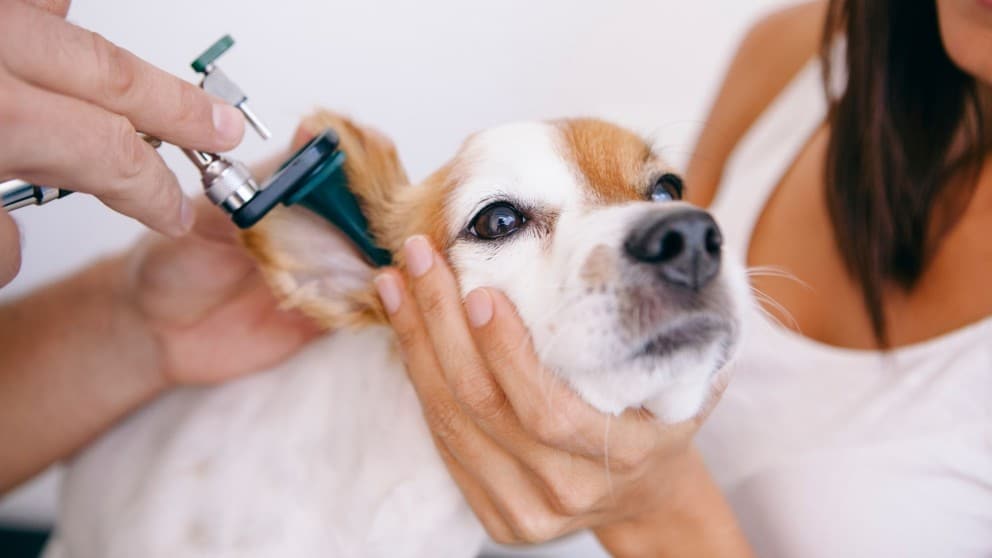What causes chronic ear infections in dogs?

When it comes to health, dogs are just like their pet parents. Some dogs will go through their entire lives without any major health problems; others seem to be susceptible to every illness that comes along. Numerous factors determine a dog’s health, with factors like genetics, environment, nutrition, and immune system health coming into play.
Ear infections are common in dogs, with inflammation, trauma, secretions, and even excessive wax. Insects and parasites can even affect the outside part of your dog’s ears, causing the pinna’s inflammation. This may result in swelling, itching, blistering, and pain.
Mites are often the cause, and will burrow under the skin along the ear’s outer edges, causing hypersensitivity. This is when your vet will need to take a skin scraping and make a diagnosis.
The American Kennel Club (AKC) explains that as many as 20% of dogs have some form of ear disease and that they’re more prone to ear infections because of their ear canals’ shape. They add that by learning how to clean your dog’s ears safely; you may prevent ear infections.
Additionally, you should take your dog to the vet as soon as you notice common signs of an ear infection. “Quick treatment is necessary not only for your dog’s comfort (these conditions can be painful!), but also to prevent the spread of infection to the middle and inner ear. Do not try to treat ear infections at home,” via AKC.
Itchy Ears or Excessive & Shaking
Yeast ear infections are more common than bacterial ear infections in dogs. Usually, you won’t notice the beginning of an ear infection, and it’s only when your dog is shaking his head and pawing his ear that you’ll know that something is wrong.
Itchy ears could mean a variety of things, from itchy ears to an ear infection. Infections of the ear and other ear disorders are common in all dog breeds. If your dog has a history of ear infections, you’ll need to discuss this with your veterinarian.
In some cases, your furry best friend may just have an itchy ear that needs to be cleaned with a cotton ball and an ear cleaner. That said, ask your vet about the most preferred dog ear cleaner for your furry best friend.
Also, get your vet tech to show you how to safely clean your dog’s ears so that you get it right from the get-go. Keep in mind that you may be damaging the ear canal if you clean your dog’s ears too often with ear washes.
Common Causes of Ear Infections
Because of the possibility of hearing loss and damage to the ear, your vet may prescribe long term antibiotics to treat ear infections. Your vet will also check for ear hematomas if your dog has fluid-filled swellings on the inward curving surface of the outer ear.
If you notice your dog shaking his head excessively or pawing his ears, visit your vet. Sometimes this may stem from environmental allergies or even a food allergy.
Here’s the take with common causes of ear infections in dogs:
- Bacterial
- Yeast
- Ear mites
- Allergies
- Hormonal changes
- Immune system issues
- Wax buildup
- Endocrine disorders
- Injury to the ear canal
- Too much cleaning
- The shape of the ear may also predispose dog breeds to ear infections.
Ear Mites (Otodectes cynotis)
Ear mites, also known as otodectic mange, are highly contagious, and you’ll need to visit your veterinarian for treatment. This is a mild parasitic infection but can become serious if your dog has an immune sensitivity reaction. In that case, you’ll notice an intense irritation of the external ear.
Although common in dogs, ear mites can infest the external ear, causing ear canal inflammation. (Otis externa) Ear mites affect both dogs and cats and are usually found deep inside the ear canal. They are also found on the dog’s body. If your dog has ear mites, this may occur:
- Shake his head
- Scratch his ear(s)
- The external ear may droop.
- Display varying intensities of itching
- Tilt head
- Display abrasions on the back of the affected ear
- Emanate a foul odor from the affected ear(s)
- Displays coffee-ground clumps of build- up in the ear
- Hematoma of the ear flap from excessive head shaking
- Long-term damage to the ear canal
- Hearing loss
- Pus in ears
- Torn eardrum
With severe cases of ear mites in dogs, the external ear will become inflamed and produce pus. Treatment will usually include a parasiticide in the affected ear and body for up to 4 weeks.
Allergies
Just like people, dogs can get allergies, as well. Dogs can be allergic to numerous substances in the air or their food. These substances, called allergens, are inhaled or absorbed through the mouth, nose, skin, or gastrointestinal tract.
Allergens will result in histamine production and inflammation. Allergic reactions can also affect the skin and cause skin infections and hot spots. Allergies will usually display the following symptoms:
Symptoms
- Skin infections
- Excessive itching with scratching and head shaking
- Excessive all over-the body itching
- Secondary signs of wounds like scabbing
- Hair loss
- Scaling
- Chewing of the paws
- Excessive ear scratching
Diagnosis is often made by symptoms after exclusions to other causes have been made. Treatment is usually long-term. With food allergies, your vet will use an elimination diet trial.
Overall Ear Problems
Itchy and painful ear causes may not be that obvious at times. It’s always necessary to visit your veterinarian as soon as you notice that your dog may have an itchy or painful ear.
That said, dogs that have extensive ear infections will need to have repeated treatments. This will involve flushing the ear debris, which is done under sedation.
The correct ear meds are also applied. If the ear infection doesn’t resolve with treatment; your veterinarian will need to rule out thyroid issues, adrenal disease, and allergies.
Scratching Ear & Excessive Head Shaking
If you have a dog that is shaking his head and scratching his ear excessively, it may also be from an inflamed ear canal. Middle and inner ear infections in pets tend to spread from outer ear infections.
Now you can see why it’s so important to take your dog to the veterinarian when ear problems first show up. You’ll be able to treat your furry best friend immediately and help him out with his pain.
Excessive Ear Wax Production
Inflammation in the ear can also stem from excessive ear wax production, resulting from bacterial or yeast infections, allergies, or ear mites. Your veterinarian may prescribe topical ear drops and possibly an antibiotic or antifungal.
Your veterinarian will do a complete examination using an otoscope. Your dog may need to be sedated to allow for this, most especially if his ear is painful or a discharge or widespread inflammatory tissue. Most dogs with ear infections will be uncooperative with ear examinations.
A tissue sample may also be needed to check for infection-causing microbes. Initially, a smear may diagnose a problem right away, like for small microorganisms living in the ear, which may cause diseases.
Signs of an ear infection usually include the following:
- Skin redness
- Itchiness
- Swelling
- Increased discharge
- Scaling of the skin area
- Walking in circles
- Possible hearing loss
- Aggression due to pain
- Tilting head to one side or head shaking or pawing of the ear.
How to Spot a Yeast Ear Infection?
With ear infections, there’s usually a yeasty smell coming from the infected ear that is easy to pick up. You can also use soft tissue and gently move your finger into the ear canal. If the tissue comes out brown, you’ll know that there’s a yeast infection or too much Malassezia in the ear.
Malassezia is a yeast that grows in a dog’s ears and skin and may be hard to get rid of. It takes a while to grow but is tenacious when present, especially in wet skin and hair.
What Are Ear Treatment Options?
Your veterinarian will do a complete examination using an otoscope. Your dog may need to be sedated to allow for this, most especially if his ear is painful or a discharge or widespread inflammatory tissue. Most dogs with ear infections will be uncooperative with ear examinations.
A tissue sample is sometimes used to check for infection-causing microbes. Initially, a smear may diagnose a problem right away, like for small microorganisms living in the ear, which may cause diseases. Your veterinarian will also check to see if your dog has any of the following:
- Low- grade infection
- Foreign objects in the ear
- Impacted debris
- Ruptured or abnormal eardrums
- Dark discharges usually mean yeast or a parasite infection, but a dark discharge may also be present with a bacterial infection.
- Aspergillus fungus
- Trauma
- Nausea and vomiting
- Foul odor coming from the infected ear
- Bulging eardrum that’s painful
- Sometimes there is nervous system damage with facial nerve damage.
- Yellow or brown discharge
- Redness and swelling of the ear canal
Ear Medications for Dogs with Ear Infections
Your vet will palpate the ear to see the pain’s severity and check for swelling and discharge. Your vet may prescribe the following pet ear meds:
- Corticosteroids
- Antibacterial drugs
- Ear mites would need a topical product that is both antibacterial and anti-parasitic
- CBD for pain
Your veterinarian may recommend an otic enzymatic the solution that treats and relieves the external ear from acute and chronic inflammation caused by bacterial, viral, and yeast infections.
Dog Ear Wipes
Ear meds are usually taken for 2-4 weeks or until the infection has cleared. Cleaning your dog’s ears regularly, and making sure that you use drying agents in dogs that swim a lot helps prevent ear infections. There are special ear wipes for dogs that make ear cleaning so much easier.
Using special dog ear wipes to keep your dog’s ears clean is an important part of pet care. It’s also important to keep your dog’s ears dry after swimming or bathing.
Dogs with long droopy ears like the Basset Hound and Cocker Spaniel needs to have special ear care. Also, dogs with a great deal of hair around the ears like the Poodle, English Sheepdog, and Schnauzer are prone to recurring ear infections. These breeds may develop swimmer’s ear where the moisture is trapped in the ear canal.
Additionally, other ear infections are often related to skin diseases like seborrhea that affects the ear canal lining. Food allergies also need to be explored to eliminate potential issues. Your veterinarian will make a full diagnosis and prescribe the correct ear medications for your dog.
That said, many ear infections in dogs can only be managed and will be recurring. It’s important to use preventative care to prevent flare-ups and high veterinary bills. With that said, pet insurance is key to allowing for the best veterinary care.
If you’re a pet parent, and your dog is prone to ear flare-ups, there’s no getting around the fact that by paying attention to your dog’s ears and taking steps to help prevent ear infections, you’ll be able to help reduce ear infections in your dog.
How often should you be taking your pet to the vet? Read more here.
Resources:



